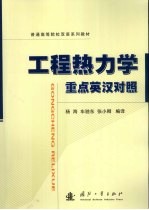图书介绍
工程热力学重点 英汉对照PDF|Epub|txt|kindle电子书版本网盘下载

- 杨海等编译 著
- 出版社: 北京:国防工业出版社
- ISBN:9787118060072
- 出版时间:2009
- 标注页数:329页
- 文件大小:22MB
- 文件页数:344页
- 主题词:工程热力学-双语教学-高等学校-教材
PDF下载
下载说明
工程热力学重点 英汉对照PDF格式电子书版下载
下载的文件为RAR压缩包。需要使用解压软件进行解压得到PDF格式图书。建议使用BT下载工具Free Download Manager进行下载,简称FDM(免费,没有广告,支持多平台)。本站资源全部打包为BT种子。所以需要使用专业的BT下载软件进行下载。如BitComet qBittorrent uTorrent等BT下载工具。迅雷目前由于本站不是热门资源。不推荐使用!后期资源热门了。安装了迅雷也可以迅雷进行下载!
(文件页数 要大于 标注页数,上中下等多册电子书除外)
注意:本站所有压缩包均有解压码: 点击下载压缩包解压工具
图书目录
绪论1
第1章 导论4
1.1 热能—机械能转变装置4
1.2 化学能—机械能转变装置6
1.3 制冷和低温装置6
1.4 工程热力学的主要内容8
第2章 基本概念和定义9
2.1 基本概念9
2.2 计量单位12
2.3 能量12
2.4 热力状态参数13
习题16
第3章 纯物质的性质17
3.1 纯物质17
3.2 纯物质的相17
3.3 纯物质的相变过程18
3.4 相变过程的状态参数图20
3.5 热力参数表23
3.6 理想气体状态方程26
3.7 比热容28
3.8 内能,焓,理想气体的比热容29
3.9 固体和液体的内能,焓和比热容32
复习思考题33
习题33
第4章 热力学第一定律35
4.1 传热35
4.2 功38
4.3 机械功39
4.4 能量分析43
4.5 控制容积的热力学分析45
4.6 稳流过程48
4.7 稳定流动能量方程的应用50
4.8 非稳流过程52
复习思考题55
习题56
第5章 热力学第二定律60
5.1 概述60
5.2 热源60
5.3 热机60
5.4 制冷机和热泵62
5.5 可逆过程和不可逆过程65
5.6 卡诺循环67
5.7 卡诺定理69
5.8 卡诺热机70
5.9 热力学温标72
5.10 卡诺制冷机和热泵72
复习思考题73
习题74
第6章 熵76
6.1 克劳修斯不等式76
6.2 熵77
6.3 熵的计算79
6.3.1 利用图解数据求熵值79
6.3.2 利用TdS等式的计算80
6.3.3 理想气体熵的计算81
6.4 内部可逆过程的熵变化,熵流82
6.5 封闭系统的熵平衡83
6.5.1 熵平衡,熵产83
6.5.2 闭口系的熵平衡84
6.5.3 熵增定律85
6.6 控制容积的熵平衡86
6.7 理想气体的过程88
6.7.1 等熵过程88
6.7.2 定压过程90
6.7.3 定温过程91
6.7.4 绝热过程91
6.7.5 定容过程93
6.8 涡轮、喷管、压缩机和泵的等熵效率93
6.9 内部可逆稳流过程的热传递和功95
6.10 压缩功的最小化97
6.11 热的可用性与能量贬值100
复习思考题101
习题102
第7章 热力学关系式106
7.1 利用状态方程106
7.2 重要数学关系109
7.3 状态参数的关系110
7.4 熵、内能和焓的变化113
7.4.1 克拉伯龙方程113
7.4.2 单相区115
7.5 其他热力学关系118
7.1 体积膨胀系数、等温压缩系数和等熵压缩系数118
7.5.2 比热容的关系119
7.5.3 焦耳—汤姆逊系数120
7.6 气体混合物的质量成分和摩尔成分122
7.7 理想气体混合物的p—v—T性质122
7.8 理想气体混合物参数124
复习思考题126
习题127
第8章 湿空气和空气调节129
8.1 干空气和大气129
8.2 湿空气的比湿度和相对湿度130
8.3 露点温度132
8.4 绝热饱和与湿球温度132
8.5 空气温湿图134
8.6 空气调节过程135
复习思考题141
习题141
第9章 高速气体流动143
9.1 滞止特性143
9.2 声速和马赫数145
9.3 一维等熵流147
9.4 通过喷管的等熵流动149
9.5 喷嘴和扩压管中的真实流动153
9.6 水蒸气喷管155
复习思考题157
习题157
第10章 气体动力循环159
10.1 动力循环分析的基本依据159
10.2 卡诺循环160
10.3 标准空气循环160
10.4 往复式发动机161
10.5 奥托循环162
10.6 狄塞尔循环165
10.7 斯特林循环和埃里克森循环167
10.8 布雷顿循环170
10.9 回热布雷顿循环174
10.10 再热、回热和中间冷却的布雷顿循环175
10.11 理想的喷气推进循环177
10.12 第二定律分析气体动力循环178
复习思考题179
习题179
第11章 蒸汽和联合动力循环182
11.1 卡诺蒸汽循环182
11.2 朗肯循环183
11.3 实际蒸汽动力循环与理想循环的偏差185
11.4 朗肯循环效率的提高186
11.5 理想朗肯再热循环187
11.6 理想朗肯回热循环189
11.7 热电联产192
11.8 双汽循环195
11.9 燃气—蒸汽联合循环系统196
复习思考题197
习题197
第12章 制冷循环200
12.1 制冷机和热泵200
12.2 逆卡诺循环201
12.3 理想的蒸汽压缩制冷循环201
12.4 实际蒸汽压缩制冷循环203
12.5 热泵系统205
12.6 气体制冷循环205
12.7 吸收式制冷系统207
12.8 温差发电和热电制冷208
复习思考题209
习题210
PREFACE214
1 INTRODUCTION218
1.1 Equipments for Thermal-Mechanical Energy Conversion218
1.2 Equipments for Chemical-Mechanical Energy Conversion218
1.3 Equipments for Refrigeration and Low Temperature219
1.4 The Main Scope of Thermodynamics for Engineering219
2 SOME BASIC CONCEPTS AND DEFINITIONS220
2.1 The Fundamental Concepts220
2.2 Units221
2.3 Energy222
2.4 Thermodynamic Properties223
3 PROPERTIES OF PURE SUBSTANCES225
3.1 Pure Substances225
3.2 The Phases of Pure Substances225
3.3 Phase-Change Processes of Pure Substances226
3.4 Property Diagrams for Phase-Change Process227
3.5 Property Tables229
3.6 The Ideal-Gas Equation of State230
3.7 Specific Heats231
3.8 Internal Energy,Enthalpy and Specific Heat of Ideal Gases232
3.9 Internal Entergy,Enthalpy and Specific Heats of Liquids and Solids233
4 THE FIRST LAW OF THERMODYNAMICS235
4.1 Heat Transfer235
4.2 Work236
4.3 Mechanical Forms of Work236
4.4 The First Law of Thermodynamics238
4.5 Control volume's thermodynamic analysis239
4.6 The Stead-Flow Process240
4.7 Applications of Energy Equation for Steady-Flow Systems241
4.8 Unsteady-flow Processes242
5 THE SECOND LAW OF THERMODYNAMICS244
5.1 Introduction244
5.2 Thermal energy reservoir244
5.3 Heat Engines244
5.4 Refrigerator and Heat Pump246
5.5 Reversible and Irreversible Processes248
5.6 Carnot Cycle249
5.7 The Carnot Principle250
5.8 Carnot Heat Engine250
5.9 Thermodynamic Temperature Scale250
5.10 Carnot Refrigerator and Heat Pump251
6 ENTROPY252
6.1 Clausius Inequality252
6.2 Entropy252
6.3 Calculation of Entropy253
6.3.1 Calculation Using Graphical Entropy Data253
6.3.2 Calculation by Using Equation of TdS253
6.3.3 Calculation of the Entropy of A Perfect Gas254
6.4 Entropy Change and Entropy Transfer in the Internal Reversible Processes255
6. 5 Entropy Balance of A Closed System255
6.5.1 Entropy Balance,Entropy Production255
6.5.2 Entropy Balance of A Closed System256
6.5.3 Increase of Entropy Principle256
6.6 Entropy Balance of the Control Volume257
6.7 The Processes of Ideal Gas259
6.7.1 Isentropic Processes259
6.7.2 Isobaric Process259
6.7.3 Isothermal Process260
6.7.4 Adiabatic Process260
6.7.5 Isochoric Process260
6.8 Isentropic Efficiencies of Turbine,Nozzle,Compressor and Pump261
6.9 Heat Transfer and Work of the Internally Reversible Steady Flow262
6.10 Minimizing Compression Work263
6.11 Heat Availability and Energy Devaluation264
7 THERMODYNAMIC RELATIONS266
7.1 Using Equations of State266
7.2 The Important Mathematical Relations267
7.3 The Property Relations268
7.4 Changes in Entropy,Internal Energy and Enthalpy269
7.4.1 Clapeyron Equation269
7.4.2 Single-Phase Regions270
7.5 Other Thermodynamic Relations270
7.5.1 Volume Expansivity,Isothermal Compressibility and Isentropic Compressibility270
7.5.2 The Relationships of Specific Heats271
7.5.3 Joule-Thomson Coefficient272
7.6 The Mass Components and Mole Components of Gas Mixture273
7.7 The p-v-T Characters of Ideal Gas Mixture273
7.8 Properties of Ideal Gas Mixture274
8 GAS-VAPOR MIXTURES AND AIR-CONDITIONING275
8.1 Dry and Atmospheric Air275
8.2 Specific and Relative Humidity of Air276
8.3 Dew Point Temperature276
8.4 Adiabatic Saturation and Wet-Bulb Temperature277
8.5 The Psychrometric Chart277
8.6 Air-Conditioning278
9 HIGH-SPEED GAS FLOW281
9.1 Stagnation Properties281
9.2 The Velocity of Sound and Mach Number282
9.3 One-Dimensional Isentropic Flow282
9.4 Isentropic Flow Through Nozzles283
9.5 Actual Flow Through the Nozzle and Dliffusers285
9.6 Steam Nozzles286
10 GAS POWER CYCLES287
10.1 Basic Considerations in the Analysis of Power Cycle287
10.2 The Carnot Cycle288
10.3 Air-Standard Assumptions288
10.4 The Reciprocating Engine288
10.5 The Otto Cyele289
10.6 Diesel Cycle290
10.7 Stirling Cycle And Ericsson Cycles290
10.8 The Brayton Cycle291
10.9 The Brayton Cycle with Regeneration292
10.10 Brayton Cycle with Reheating,Regeneration and Inter-Cooling293
10.11 Ideal Jet-Propulsion Cycle294
10.12 Second Law Analysis of Gas Power Cycle294
11 VAPOR AND COMBINED POWER CYCLES295
11.1 The Carnot Vapor Cycle295
11.2 Rankine Cycle:The Ideal Cycles for Vapor Power Cycles295
11.3 Deviation of Actual Vapor Power Cycles From Idealized Ones296
11.4 Increasing Thermal Efficiency of The Rankine Cycle296
11.5 The Ideal Reheat Rankine Cycle297
11.6 The Ideal Regenerative Rankine Cycle297
11.7 Cogeneration298
11.8 Binary Vapor Cycles299
11.9 Combined Gas-Vapor Powr Cycles300
12 Refrigeration Cycles301
12.1 Refrigerators and Heat Pumps301
12.2 The Reversed Carnot Cycle301
12.3 Ideal Vapor-Compression Refrigeration Cycle302
12.4 Actual Vapor-Compression Refrigeration Cycle303
12.5 Heat Pump System303
12.6 Gas Refrigeration Cycle303
12.7 Absorption Refrigeration Systems304
12.8 Thermoelectric Power Generation and Refrigeration System305
附录306
附表1 各种单位制常用单位换算表306
附表2 低压时一些气体的热力性质307
附表3 空气的热力性质表308
附表4 气体的平均比定压热容310
附表5 气体的平均比定容热容311
附表6 气体的平均定压容积热容312
附表7 气体的平均定容容积热容313
附表8 饱和水与水蒸气的热力性质表(按温度排列)314
附表9 饱和水与水蒸气的热力性质表(按压力排列)316
附表10 未饱和水与过热水蒸气的热力性质318
参考文献329